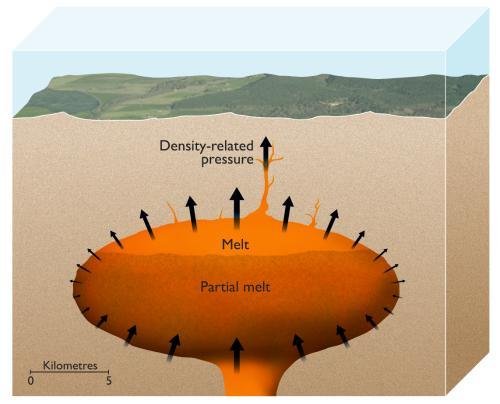An artist's impression of the magma chamber of a supervolcano with partially molten magma at the top. The high pressure created by the liquid magma has the capability to crack through 10 kilometers of the Earth's crust. (Credit: ESRF/Nigel Hawtin)
Supervolcano eruptions occur spontaneously, triggered by magma pressure alone and not other external factors like earthquakes, as previously thought.
Using synchrotron X-rays scientists at the European Synchrotron Radiation Facility recreated the conditions inside a supervolcano, capable of eruptions a thousand times larger than regular volcanic explosions, to show that the large volume of magma was enough to trigger these large eruptions.
"Now we know you don't need any extra factor -- a supervolcano can erupt due to its enormous size alone," said lead author Wim Malfait, of ETH Zurich. "Once you get enough melt, you can start an eruption just like that."
Because the process involved in such eruptions is different form regular volcanic eruptions, they filled a diamond capsule with synthetic magma and fired high-energy X-rays at it, to simulate the intense heat and pressure inside these supervolcanoes.
The results, which have been published in Nature Geoscience, showed that that transition from solid to liquid magma can create pressure strong enough to crack through 10 kilometers of the Earth's crust above the magma chamber.
"Magma penetrating into the cracks will eventually reach the Earth's surface. And as it rises, it will expand violently - causing an explosion," said Carmen Sanchez-Valle, also of ETH Zurich.
One of the best-documented supervolcano explosions was in Wyoming 600,000 years ago, which created a huge crater at the center of what is today called the Yellowstone National Park. The eruption spewedmore than 1000 cubic kilometers of ash and lava into the atmosphere, 100 times more than Mt. Pinatubo in the Philippines did in 1991.
"You could compare it to an asteroid impact -- the risk at any given time is small, but when it happens the consequences will be catastrophic," said Malfait.
[ESRF]
[Nature Geoscience]
[BBC]















